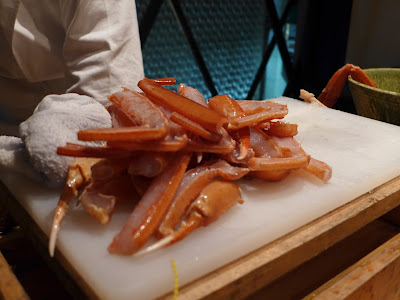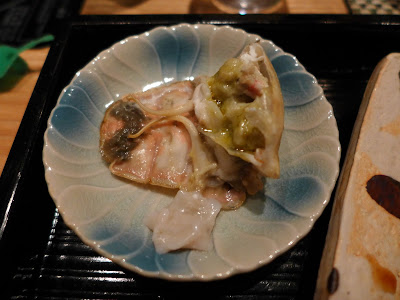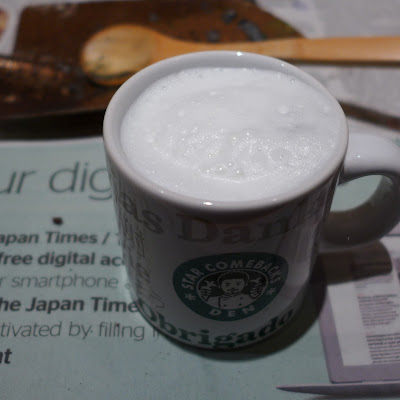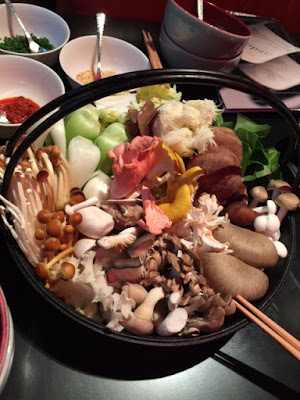Tokyo, Japan Fall 2016
After several trips to Japan in the fall, i have come to believe that there are few countries in the world that display such brilliantly beautiful fall foliage and that beauty is well reflected in their "kaiseki" cuisine, their version of haute cuisine that is so reflective of the seasons.
Dainty maple leaves in fall colours beuatifully contrast with the colours of the mosses on the ground.
An example of the presentation of a dish in a great kaiseki restaurant. The colours of the dishes (in this case a dish in a leaf shape) and platters, and the presentation of the seasonal elements and colours in the dish, are such an elegant and refined representation of the season.
Kitafuku
Kitafuku is a unique 2 ½ hour
experience, the only live specialty restaurant in Tokyo. The experience is virtually all about eating the very best,
freshest quality giant crab. A live, Typically a 4-6 lb king crab, is slowly and carefully dismantled
and de-shelled by your own private chef, in your own private room. Each leg, its component parts, claw by claw are gradually separated,
shelled and feasted upon in stages, served raw, rare, medium rare by being boiled
in delicious stock and charcoal-grilled.
Kitafuku’s crab feast begins
with sashimi. The live and sentient crab’s legs are snipped off with clippers or a large chef knife, at the body. We are assured that the crab does not feel any pain, and there is
no evidence of any struggle. The crab’s snipped legs are placed in iced water
to be served raw, rare or medium rare. The rest of the crab is boiled in crab
stock or grilled over bincho charcoal. The crab’s meat is eaten at various
stages of texture and flavour.
Egg custard with Shanghai crab with crab broth with a creamy texture, fortified with Japanese arrowroot.
Wild Kojima Bay eel with sudachi lime, roasted akakanzashi carrot from Kyoto accompanied by sea salt.
The ingredients for a shabu shabu of kinki fish (channel rock fish) and matsutake mushrooms from Hiroshima.
The prep: the broth used is made from grilled kinki fish head and bones, and bonito flakes.
The presentation of the shabu shabu ingredients. Delicious!
My fabulous ceramic plate for the forthcoming dish.
This is the kind of live crab typically served at the resto. However, we were honoured with the very rare crabs below.
Because of our special connections with the resto owner we were honoured with 3, very rare, large golden crabs, a cross between a snow crab and red king crab. Only 1 out of a thousand crabs caught are coral crabs.
The live crab on the special counter ready to be dismantled.
Stage one, the removal of the legs from the live crab.
The legs separated into their component parts and de-shelled.
The body, reserved and taken into the kitchen for prep and cooking.
The raw legs are soaked in iced water in a solution that slightly cures the meat. Then, they are mounted on this traditional, special rack and passed to the clients to be eaten.
Parts of the legs are slightly boiled in the crab broth and presented rare.
More dissection.
This part of the leg is eaten medium rare after being boiled in crab stock.
The presentation of the boiled crab claws.
The boiled claws and charcoal grilled remaining leg parts, presented with sudachi lime and sea salt.
The crab tail meat, belly and heart (bottom) are presented to be eaten.
The presentation of the crab bodies.
The crab body presented with sudachi lime. This is a truly delicious mixture of crab meat, crab roe and crab tomalley.
When in season, it is traditional to serve salmon roe. Trust me when I say that when salmon roe is presented in season at the very best Japanese restos, it is the freshest you will have ever tasted and the best you will have ever tasted This roe is a unique gustatory experience. Notice the fluidity of the eggs. The egg wall is such that the eggs abruptly burst against your palate when squeezed with your tongue. These eggs have no stickiness (they do not stick together). There is a fluid vehicle in which they sit.
Crab "porridge" consisting of the crab broth, crab meat and crab roe.
Pickled vegetables.
Beef shigureni, cooked in soy sauce with ginger and mirin.
Persimmons are in season (you will see them often served for dessert in this current Japanese blog), and here served with cream cheese.
A second dessert was red bean (adzuki) and chestnut cake that used chestnuts from Tanba.
Kushikatsu Bon
This is a resto known for a special version of tempura called kushi age, where every deep fried item is presented on a skewer.
The resto and the enclosed deep fryer.
The beginning presentation, salad and a divided plate of mustard, ponzu, soy and sea salt, for dipping.
Mixed seafood in a shiso wrap around bechamel, prawn, scallop, cheese, wild snapper and tofu skin.
Prawn.
Black hair beef yamagata A5 with mustard sauce.
Zucchini topped with grated daikon and foie gras.
Fu (or ofu) rice crackers with millet and gluten
Asparagus.
The truly exceptional black hair yamagata A5 black haired beef sandwich, made from a special portion of the chateaubriand filet, coated and deep fried a perfect med rare/rare and presented in perfect, soft squishy white bread. An exceptional sandwich that is not "on the regular menu" (there is no menu as everything is omikase) and is a takeout or eat-in lunch item.
Shiitake mushroom stuffed with minced chicken.
Tomato, cheese and basil, deep fried and wrapped with prociutto.
Rice with chestnuts and chives.
Pickles of kombu and kombu daikon.
Presentation of miso soup.
The soup.
Persimmon sorbet.
Sukiyabashi Jiro
The inauspicious entrance to Sukiyabashi Jiro, a Michelin 3 star resto.
At serious sushi restaurants "conversation" is considered taboo. That is not to say that one can't make comments to each other. But, in the most serious establishments, there is little talking or conversation. There is a quiet contemplative silence and the decor of the room and the feature of the tokonoma (alcove) in the restaurant, if there is one, contribute in a most pleasant way to one's contemplation in the silence of the food.
Jiro made and placed the sushi in front of us, rather quickly and we were expected to eat it immediately so that the sushi rice and fish were at the correct temperature when eaten.The time it takes from the first piece of sushi until the typical tomago ending is precisely 30 minutes for everyone who eats at Jiro!!
NO photos are allowed at Jiro.
The following courses below were the sushi we were served this season. In each case the fish is brushed by Jiro with his own house made Nikiri soy sauce or tsume ( a slightly sweet version), depending on the fish. So, I never adulterated my sushi with soy sauce. Jiro discourages the practice of dipping sushi into soy sauce.
Jiro uses a special grade of rice exclusively available to him. Jiro makes his sushi with an extremely light touch so that it has air in the rice patty. The loosely packed rice the fish is mounted on is faintly acidic to contrast with the fish and seemed roughly body temperature.
Jiro recommends shoga (pickled ginger) to be tasted minimally (a pinch), to reduce palate burn and he suggests that it be only tasted after fattier fish, to remove the after taste of the fat.
The nori used at Jiro is freshly roasted over bincho charcoal each day.
Jiro only presents nigiri (sushi). There are no appetizers.
The courses:
Karei (marbled sole)
Ink squid
Striped jack
Akami maguro (lean bluefin tuna) previously marinated in soy sauce (zuke)
Chutoro (medium fatty bluefin tuna)
Otoro (fatty bluefin tuna). To Jiro, the fragrance of the fish is more important than the fattiness. Only 1/100 fish meet the standards of Jiro!
Kohada (gizzard shad), marinated in vinegar before serving.
Awabi (steamed abalone). Abalone is simmered in sake and water for 3-4 hours, then left to cool in its own broth, releasing the fragrance. The scent is further released by the scoring of fine cuts in the fish.
Jack mackerel
Akagai (ark shell) (red clam) (served fresh straight out of their shell!!!!)
Sayori (Needle fish) (half beak).
Karuma ebi (Japanese tiger prawn boiled just before serving, but served about room temp), served in 2 pieces.
Bonito
Shako (mantis shrimp), is roasted before service, over burning straw.
Vinegared jack mackerel
Hamaguri (clam shell). Briefly placed on a fire and then steeped in a sugar soy broth.
Uni (sea urchin)
Baby scallops
Ikura (salmon roe). Jiro marinates the roe in his own light soy sauce, giving the roe a smooth texture and round taste.
Anago (sea eel)(conger eel). Jiro only simmers his eel and does not broil it after.
Tomago (egg omelette). This was superb. Jiro mixes yamato-imo (Japanese yam) and shrimp with the eggs and grills the tamago for about an hour.
We were escorted to a table and served dessert and then presented with the bill.
Aragawa
Aragawa is one of the great steak restaurants in Japan.
Whole Scottish salmon is smoked by the resto every week and this was superb, beautifully smoked allowing the flavour of the best salmon to come through.The flesh was moist and juicy. Served alongside, pickled cucumber and lemon.
The presentation of our A5 striploin before cutting. Two qualities of beef are available, "regular" and "supreme". We chose the supreme and requested it be cooked med-rare-rare.
Our sliced steak presented with corn kernels, snow peas and braised carrots. This was exceptionally good Japanese beef: extremely tender, very juicy and very flavourful.
Seasonal persimmon.
Udon bowl
Shabu shabu duck udon
Vegetable udon bowl.
How the udon bowl is presented.
Jimbocho Den
Den, owned by the talented chef Zaiyu Hasegawa, is a one Michelin star restaurant serving only 8 seats on the bar. The chef and his english speaking wife have a very warm, light-hearted approach to cuisine and entertaining. The dishes are quite playful and the chef's sense of humour is very much a part of most dishes.
The thin, crispy cracker was deliciously filled with foie gras, sweet potato, white soy bean paste and guava jam. The chef's wife explained that this dish was a whimsical twist on the classical Japanese Monaka, a type of snack.
After a bight, regrettably blurred, probably from the excitement of the dish
The presentation of turtle soup. Tapping the top of the scull, the jaws move and the chef takes the opportunity of demonstrating his ventriloquism.
Soft shelled turtle soup with turnip.
This plate was presented to give us a clue of what was to come. The chef's humour again.
We we presented with this box placed on the plate.
We opened the box, and were confronted with a seasonal fall presentation, under which was a fried chicken wing.
The "dentucky" fried chicken was stuffed with sticky rice, porcini, ginko nut and hazelnuts. A delicious concoction.
Spanish mackerel sashimi that had been marinated in a broth of konbu seaweed, soy sauce and vinegar and topped with shiso leaves and blossoms.
Beef cheek, simmered in broth with quinoa, turnip from Ayame, baby turnip and carrot.
The presentation of the salad consisting of 20 kinds of veggies, some of which were tomato that had been marinated in rice, begonia flower, pumpkin, hayato gourd, purple radish, carrot, roasted tea powder and and flavoured with a dressing of vinegar, sugar and vanilla.
A close up of the salad.
A further close up presenting one single ant (the chef thought this was funny). I never eat insects. Just no pleasure in them. But I ate this. Still no pleasure!
A slice of botarga.
The chef presents cherry shrimp rice.
Close-up of the rice.
Pickles.
The rice with the shrimp.
The rice served with the pickles and soup.
Pear, pear jelly and begonia flowers.
A newspaper was placed on the counter that had some letters highlighted, which combined formed the phrase “See you soon”. Then the sou-chefs entered the dining area from the front door, each carrying hand shovels and working gloves. They folded the gloves into a form of a bunny with its ears and placed it beside a "muddy" shovel covered with "dirt". The shovel contained tiramisu, cream cheese, buckwheat seeds, tea leaves and charcoal powder..
A closeup of the shovel contents.
We were then served a "Starbucks " ...."star comebacks* Den"mug. The "atr comebacks" phrase was a reflection of the fact that Den, formerly a 2** star resto lost 1 Michelin star.
The "capuccino: in the mug in the mug was sugar cane pudding with Black Truffle, the combination had a slightly bitter flavor similar to coffee.
Chinaroom at the Grand Hyatt Hotel, Tokyo
Mushroom hotpot. A large cast iron container filled with a very rich chicken broth was place on a portable electric grill on our table and set to simmer. The veggies, mainly baby bok choi, were initially placed in the chicken stock to slowly cook. after about 7 minutes a variety of each mushroom was placed in the broth to simmer for 6 minutes. This was the best mushroom soup I have ever tasted and was worth the journey! Intense!



























































































No comments:
Post a Comment